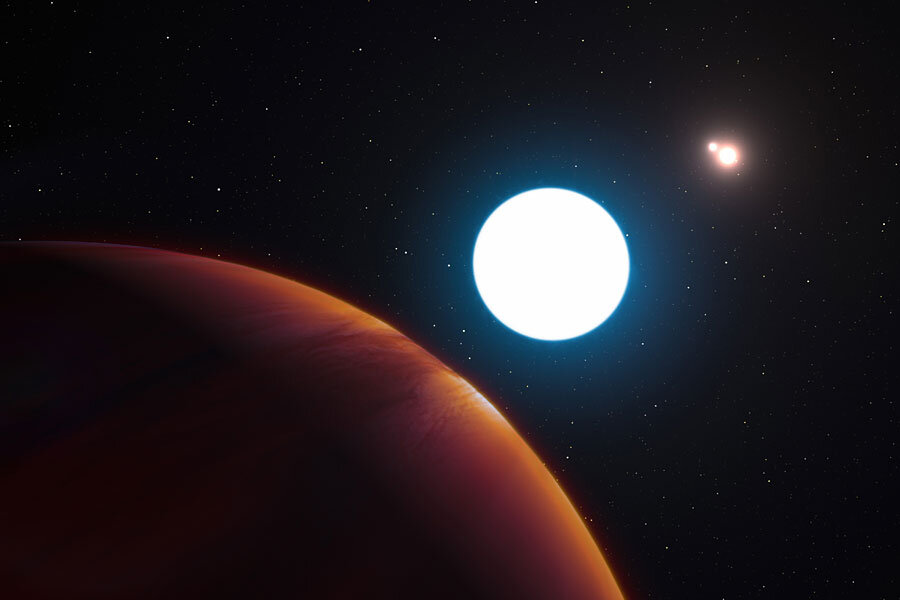This massive planet has three suns, and that's not all that's weird about it
Loading...
About 320 light years away lies a large exoplanet in a triple star system.
It may sound like a planet straight out of the fictional realm of Star Wars, but this world actually exists in our galaxy. Astronomers spotted HD 131399Ab, as the new exoplanet is dubbed in a paper published Thursday in the journal Science, and its three stars using direct imaging, so they have a snapshot of this bizarre, star-filled world.
And that's not all that's otherworldly about this system. By the astronomers' calculations, HD 131399Ab shouldn't be there.
The exoplanet sits between its three stars, with each fiery orb pulling at the smaller celestial body. And its orbit suggests that this exoplanet may actually be teetering on the edge of being ejected from its star system.
"All of the other planets in multiple star systems that we know about orbit much closer to one of the stars, so it's much more reminiscent of the case of a planet orbiting a single star. The other stars are so far off in the distance that they don't really have much of an effect on the planet," Kevin Wagner, an astronomy PhD student at the University of Arizona who discovered the strange new exoplanet, tells The Christian Science Monitor. "But this planet is about a third of the way in between the stars."
In other words, HD 131399Ab orbits star A, but the exoplanet's orbit brings it a third of the way to the other two stars, B and C, which are close together. And when it's at that point, the exoplanet feels the gravitational attraction of the other two stars.
A third of the way to the other stars is about where scientists would expect the exoplanet's orbit to become unstable, and therefore place the body in danger of being ejected from the system to become a free-floating planetary mass object.
But, "we think that it is stable," Mr. Wagner says.
If HD 131399Ab were on an unstable orbit, it should have been ejected by now, Wagner explains. It would have taken just a few of its centuries-long orbits interacting with the gravitational pull of the other two stars to force the exoplanet out of the system entirely. And this system is about 16 million years old.
This doesn't rule out the possibility of the system being or becoming unstable, Jason Eastman a research associate at the Harvard-Smithsonian Center for Astrophysics who was not part of the research team, tells the Monitor. Because the team has studied the planet for only about one year of an orbit that takes 550 Earth-years, "the uncertainties are large," he says.
"We're going to have to wait a little bit longer before we can refine our estimates on the planet's orbit," Wagner agrees, saying that the stars may have pulled at the orbit of the exoplanet over time, changing its orbit, and, because the system is so astronomically young, it may still be unstable.
Still, Wagner says, this discovery suggests that a system like this, "although it seemed very likely that it would not form, actually can come into being."
And studying this system could teach astronomers more about the conditions under which planets can form or migrate.
Much like Jupiter, HD 131399Ab is a gas giant, made up of mostly hydrogen and helium. But the exoplanet is four times the size of its analogue in our own solar system.
All three stars are visible in the sky of the exoplanet for about half of its 550-year orbit.
As Wagner describes it in a press release: "For much of the planet's year the stars appear close together, giving it a familiar night-side and day-side with a unique triple-sunset and sunrise each day. As the planet orbits and the stars grow further apart each day, they reach a point where the setting of one coincides with the rising of the other - at which point the planet is in near-constant daytime for about one-quarter of its orbit, or roughly 140 Earth-years."
This discovery "shows that you can really find planets everywhere. Their formation process is so robust and so diverse that you can really expect to find them in a very large, very diverse stellar population," Veselin Kostov, a NASA postdoctoral fellow at Goddard Space Flight Center and a member of the Kepler Eclipsing Binary Working Group who was not part of the research team, tells the Monitor. "The stellar systems in the universe are extremely diverse and so are their planetary systems. And this is yet another example of this."
"What's cool about this, and all sorts of discoveries like this, is that it's the first of its kind and so it challenges what we know and what we think we know," Dr. Eastman says. "It reminds you how strange a world can be. It doesn't necessarily have to be like we are, with one sun and orbiting a fairly constant star, you can have a lot of different configurations."







